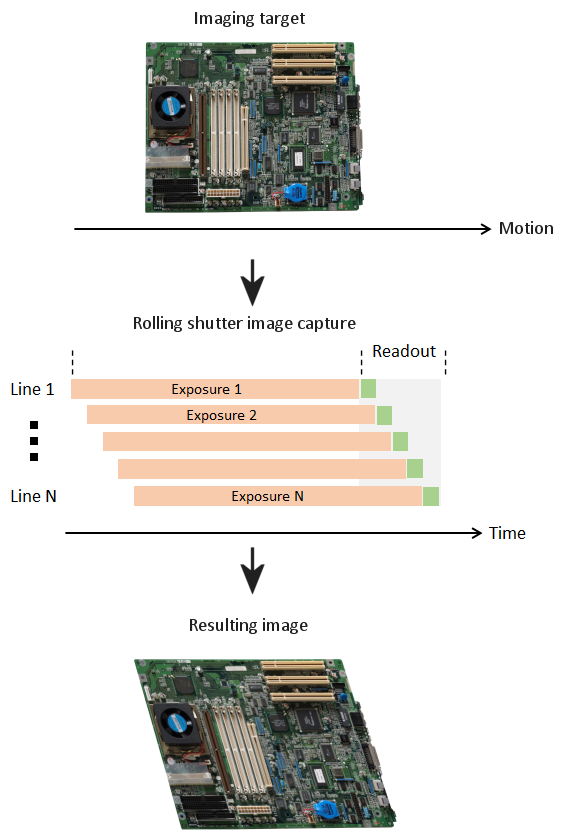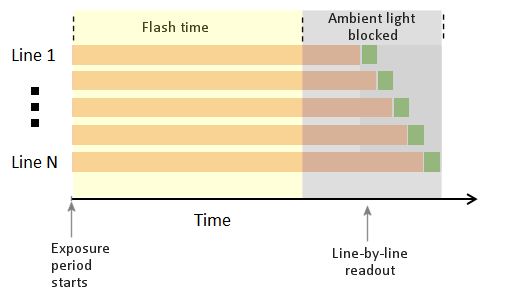
With "Global Reset" the answer is "yes, but..."
In a recent blog we talked about JAI's newest Go-X Series cameras which feature CMOS imagers with "rolling shutter" technology. As noted, this technology has the advantage of being simpler to produce and easily supports smaller pixel sizes, making cameras with rolling shutters more economical than global shutter cameras and thus an attractive option for extremely price-sensitive vision systems.
But, as we also pointed out, these cost savings come with one big drawback. Because rolling shutter cameras use an image capture method where the exposure of each line is slightly delayed from the start of the preceding line, images taken of moving objects appear "skewed" as if they were tilted backwards in the frame (see below).
Image distortion (skew) caused by rolling shutter

Addressing the issue with "Global Reset"
To address this issue, some rolling shutter sensors – including the sensors in the Go-X Series rolling shutter cameras – have a "Global Reset" mode that can be used when capturing images of continuously moving objects.
With Global Reset, all lines in the sensor are simultaneously "reset" at the start of each frame so they can begin exposing at the same time – just like in a global shutter camera. However, because the simpler design of rolling shutter sensors requires that lines are read out as soon as they finish exposure (there are no on-sensor storage nodes), the end of the exposure period must still be staggered line-by-line to make sure the readout function is available when a line is ready. As a result, the last lines in the sequence have a longer exposure time than the first lines in the sequence.
In this way, Global Reset mode eliminates the "skew" problem since all lines start exposing when the object is in the same position. But unfortunately, due to the increasing line-by-line exposure durations, the bottom of the image will appear to be brighter than the top of the image and may also be less sharp due to motion blur (see below).
Rolling shutter with Global Reset
Darker exposure at top and increased motion blur at bottom

The solution: Global Reset with flash illumination
The only way to capture images of continuously moving objects with a rolling shutter camera while eliminating skew as well as gradations in exposure and sharpness, is to combine global reset mode with a flash illumination source. For best results, one must also make sure that ambient lighting is tightly controlled.
Here's how it works. The rolling shutter camera is set to Global Reset mode and then is triggered to capture an image of a rapidly passing object. Ideally, the target field of view is placed under some sort of shroud so that all ambient light is blocked. All lines begin exposing simultaneously after which a timed flash is triggered to provide the proper exposure for the image. The camera's exposure time must be set so that the first line is "active" for a period that is equal to or greater than the flash duration. The remaining lines will all have longer active periods, but because ambient light has been blocked by the shroud, the exposure for all lines will come from the flash and will be the same.
Global Reset with flash illumination

Weighing the trade-offs
This approach lets the vision system utilize a less expensive rolling shutter camera while avoiding the biggest drawback of the technology – spatial distortion of moving objects. However, it requires the use of shrouding and flash illumination, the cost and complexity of which may negate any advantage over simply using a global shutter camera in the vision system.
Some applications may be less demanding in terms of exposure uniformity. In these cases, shrouding may not be needed. The use of a bright flash may be enough to reduce the effect of any ambient light to an acceptable level, thereby making a less expensive rolling shutter camera the preferred choice, especially in multi-camera systems where the cost savings are magnified.
In conclusion, rolling shutter cameras can definitely provide attractive cost savings for stop-and-go style applications where there is no concern about spatial distortion from the movement of the target object. In continuous motion applications, rolling shutter cameras may still be considered, but only if they have a "Global Reset" mode, and only if the cost and complexity of flash illumination and ambient light control makes sense when compared against the use of a global shutter camera.
You can learn more about the Go-X Series rolling shutter cameras at: https://news.jai.com/jai-expands-its-go-x-series-with-new-rolling-shutter-cameras
For a complete listing of all Go-X Series cameras, including links to individual product pages where you can download datasheets and other information, please go to: https://www.jai.com/go-x-series
